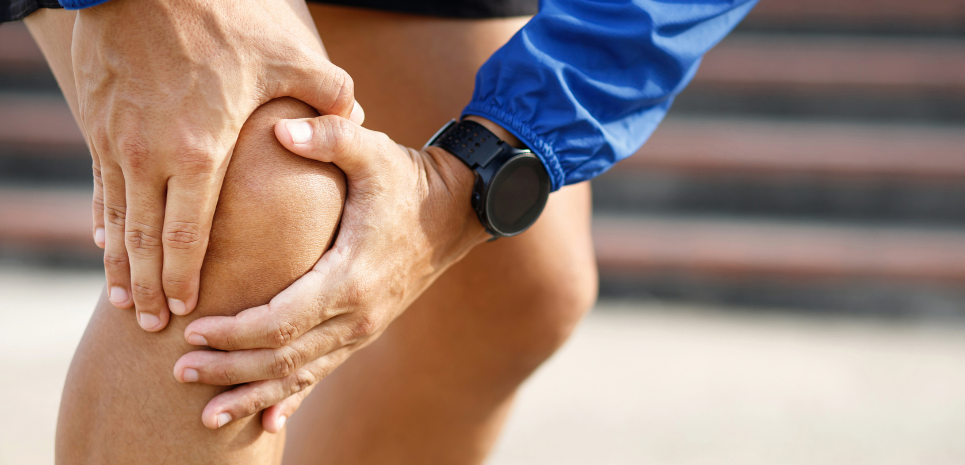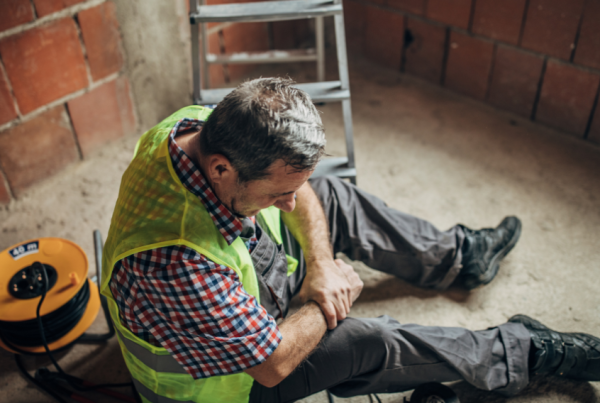Knee Pain
Move Better. Live Fuller. Your Wellness Journey Starts Here.
Schedule a FREE Discovery Call!
About Knee Pain
Your knees support your body’s weight and absorb the impact from activities you perform all day, every day—these daily stressors make knee pain a common complaint for many people. Although it is a common issue, that doesn’t make it normal.
Knee pain can be created for a couple of reasons, such as aging, repetitive use, or injury. Symptoms from knee conditions can differ slightly depending on the cause, and may include some or all of the following:

- Pain: Knee pain can be felt in a few different areas, such as inside the knee, around or behind the knee, or even in the surrounding areas of the leg. It may come and go, only appearing at certain times of the day or during specific movements. It may feel dull, achy, sudden, frequent, or intermittent.
- Pain with movement: Those with knee troubles may find that their pain worsens with movement or activity, or that it is more noticeable after a period of inactivity (such as after sleeping).
- Swelling or inflammation: Problems with the knee may cause swelling, redness, or inflammation around the affected area.
- Limited range of motion: Walking and other activities requiring movement may be difficult, as the knee may be stiff and have limited mobility.
- Weakness or instability: Similarly to the limited motion, the knee may feel weak and unable to properly support the body. This can make it difficult for some individuals to walk or balance without a supportive aid.
- Inflexibility: Utilizing the knee normally such as when bending or straightening the leg may prove challenging, limiting your ability to walk or use stairs as normal.
- Popping sounds: Knee problems, especially with injury, may create sounds of popping or crunching.
- Locking: The knee may be difficult to move, bend, or straighten—creating a feeling that it is “locked” into place.
What Causes Knee Pain?
Knee pain can have a number of causes, but it is often the result of aging, injury, or repeated stress. The knee experiences a lot of stress from daily activities of lifting, walking, high impact exercises, or sports. Therefore, it is susceptible to a variety of injuries. Some conditions or injuries of the knee include:
Ligament Tears
- Anterior cruciate ligament (ACL) injury: The ACL ligament connects your thigh bone to your shinbone. Injuries to this ligament can create swelling, pain, popping noises, and instability in the knee.
- Posterior cruciate ligament (PCL) injury: The PCL is a ligament that connects your upper and lower leg. It is larger than the ACL and is found in the back of the knee. Injuries to this ligament are less common and are usually experienced among those who play sports.
- Medial collateral ligament (MCL) injury: This ligament connects the shin bone to the thigh bone, and is one of the more common sports injuries. The severity of the injury and symptoms can vary, but usually involve pain, swelling, stiffness, and difficulty walking.
- Lateral collateral ligament (LCL) injury: This ligament prevents the knee from making abnormal outward movements. Injury to this ligament is more common in sports, and can cause tenderness, instability, pain, and swelling.
Arthritis
- Osteoarthritis: The wearing down of cartilage (protective tissue) caused by the general wear and tear that comes with aging. Often causes stiffness and pain.
- Rheumatoid arthritis: An autoimmune disease that attacks joints in the body, such as the knees. Causes symptoms like pain and swelling.
Strains
- Quadriceps strain: Occurs when the quadriceps muscle is pulled or overstretched. This type of injury can irritate the knee and make it painful to bend or straighten the leg.
- Hamstring strain: The hamstrings help bend the knee. An injury to those tendons can create pain in the back of the knee and difficulty when walking.
Other Causes
- Fractures: Fractures are created by an injury and may make it difficult to straighten or bend the knee. Fractures can create swelling, pain, and bruising.
- Bursitis: Knee bursitis occurs when the small, fluid-filled sacs (bursae) in the knee become inflamed. These sacs cushion the bones and tendons and prevent friction between them. Bursae can become inflamed from repetitive motions or pressure, such as kneeling. Bursitis can worsen over time and cause pain, tenderness, and swelling.
- Aging: Knee pain differs from person to person (each person’s body and experiences are different), but regardless the knees will deteriorate with age as the cartilage wears down or as people live with past injuries.
Knee pain, no matter the cause, isn’t something you have to deal with forever. Physical therapists are very skilled at strengthening the body and relieving pain, and can address most knee conditions. If your knee pain is from an injury, it is essential to seek physical therapy to regain proper function—especially in the case where surgery is necessary for your condition.
Physical Therapy for Knee Pain
Physical therapy can be an integral part of maintaining the health of your knees. As mentioned earlier, many knee problems originate over time due to repeated stress. The knees continuously absorb the impact of all the different activities the body performs, each and every day. Additionally, some individuals are more predisposed to knee pain than others, such as those who play sports, perform high impact exercises or jobs, or who have preexisting conditions. And for every person, the body—and knees—will naturally weaken with age.
In any of these cases, physical therapy can strengthen the muscles that support the knees, allowing them to better handle daily stressors and improve range of motion. A physical therapist is skilled in improving walking patterns, posture, or habits which can lessen your pain and prevent future injury.
In terms of more serious cases such as with major injuries, physical therapy is essential to restoring the knee’s function and flexibility after surgical treatment and preparing the body for the procedure beforehand. In some cases, physical therapy can help avoid the need for surgical intervention in the first place!
Rest assured that your physical therapist will determine the best course of action to improve the health of your knees—by creating an individualized plan that is catered to your unique case. When starting physical therapy for your knee pain, your physical therapist may begin by discussing your medical history and any related past injuries that may contribute to your pain.
They will also observe your knee, its function, range of motion, and appearance. The physical therapist will palpate the area to check for swelling or abnormalities. From there, you can expect a personalized plan of care that will improve function, flexibility, and range of motion for your knee.
Not only that, but your physical therapist can help you manage pain and other symptoms through a range of treatments. At Hive Therapy and Wellness, our physical therapists may use any of the following treatments to address knee pain:
- Dry needling
- Cupping
- Manual therapy
- Spinal manipulation
- Electrical muscle stimulation
- Tissue scraping
- Exercise prescription
- Behavioral modifications
- Therapeutic modalities
- Neuromuscular re-education
- Biofeedback
- Therapeutic activity
Your knees support your body’s weight and absorb the impact from activities you perform all day, every day—these daily stressors make knee pain a common complaint for many people. Although it is a common issue, that doesn’t make it normal.
Knee pain can be created for a couple of reasons, such as aging, repetitive use, or injury. Symptoms from knee conditions can differ slightly depending on the cause, and may include some or all of the following:
- Pain: Knee pain can be felt in a few different areas, such as inside the knee, around or behind the knee, or even in the surrounding areas of the leg. It may come and go, only appearing at certain times of the day or during specific movements. It may feel dull, achy, sudden, frequent, or intermittent.
- Pain with movement: Those with knee troubles may find that their pain worsens with movement or activity, or that it is more noticeable after a period of inactivity (such as after sleeping).
- Swelling or inflammation: Problems with the knee may cause swelling, redness, or inflammation around the affected area.
- Limited range of motion: Walking and other activities requiring movement may be difficult, as the knee may be stiff and have limited mobility.
- Weakness or instability: Similarly to the limited motion, the knee may feel weak and unable to properly support the body. This can make it difficult for some individuals to walk or balance without a supportive aid.
- Inflexibility: Utilizing the knee normally such as when bending or straightening the leg may prove challenging, limiting your ability to walk or use stairs as normal.
- Popping sounds: Knee problems, especially with injury, may create sounds of popping or crunching.
- Locking: The knee may be difficult to move, bend, or straighten—creating a feeling that it is “locked” into place.
Knee pain can have a number of causes, but it is often the result of aging, injury, or repeated stress. The knee experiences a lot of stress from daily activities of lifting, walking, high impact exercises, or sports. Therefore, it is susceptible to a variety of injuries. Some conditions or injuries of the knee include:
Ligament Tears
- Anterior cruciate ligament (ACL) injury: The ACL ligament connects your thigh bone to your shinbone. Injuries to this ligament can create swelling, pain, popping noises, and instability in the knee.
- Posterior cruciate ligament (PCL) injury: The PCL is a ligament that connects your upper and lower leg. It is larger than the ACL and is found in the back of the knee. Injuries to this ligament are less common and are usually experienced among those who play sports.
- Medial collateral ligament (MCL) injury: This ligament connects the shin bone to the thigh bone, and is one of the more common sports injuries. The severity of the injury and symptoms can vary, but usually involve pain, swelling, stiffness, and difficulty walking.
- Lateral collateral ligament (LCL) injury: This ligament prevents the knee from making abnormal outward movements. Injury to this ligament is more common in sports, and can cause tenderness, instability, pain, and swelling.
Arthritis
- Osteoarthritis: The wearing down of cartilage (protective tissue) caused by the general wear and tear that comes with aging. Often causes stiffness and pain.
- Rheumatoid arthritis: An autoimmune disease that attacks joints in the body, such as the knees. Causes symptoms like pain and swelling.
Strains
- Quadriceps strain: Occurs when the quadriceps muscle is pulled or overstretched. This type of injury can irritate the knee and make it painful to bend or straighten the leg.
- Hamstring strain: The hamstrings help bend the knee. An injury to those tendons can create pain in the back of the knee and difficulty when walking.
Other Causes
- Fractures: Fractures are created by an injury and may make it difficult to straighten or bend the knee. Fractures can create swelling, pain, and bruising.
- Bursitis: Knee bursitis occurs when the small, fluid-filled sacs (bursae) in the knee become inflamed. These sacs cushion the bones and tendons and prevent friction between them. Bursae can become inflamed from repetitive motions or pressure, such as kneeling. Bursitis can worsen over time and cause pain, tenderness, and swelling.
- Aging: Knee pain differs from person to person (each person’s body and experiences are different), but regardless the knees will deteriorate with age as the cartilage wears down or as people live with past injuries.
Knee pain, no matter the cause, isn’t something you have to deal with forever. Physical therapists are very skilled at strengthening the body and relieving pain, and can address most knee conditions.
If your knee pain is from an injury, it is essential to seek physical therapy to regain proper function—especially in the case where surgery is necessary for your condition.
Physical therapy can be an integral part of maintaining the health of your knees. As mentioned earlier, many knee problems originate over time due to repeated stress. The knees continuously absorb the impact of all the different activities the body performs, each and every day.
Additionally, some individuals are more predisposed to knee pain than others, such as those who play sports, perform high impact exercises or jobs, or who have preexisting conditions. And for every person, the body—and knees—will naturally weaken with age.
In any of these cases, physical therapy can strengthen the muscles that support the knees, allowing them to better handle daily stressors and improve range of motion. A physical therapist is skilled in improving walking patterns, posture, or habits which can lessen your pain and prevent future injury.
In terms of more serious cases such as with major injuries, physical therapy is essential to restoring the knee’s function and flexibility after surgical treatment and preparing the body for the procedure beforehand. In some cases, physical therapy can help avoid the need for surgical intervention in the first place!
Rest assured that your physical therapist will determine the best course of action to improve the health of your knees—by creating an individualized plan that is catered to your unique case.
When starting physical therapy for your knee pain, your physical therapist may begin by discussing your medical history and any related past injuries that may contribute to your pain.
They will also observe your knee, its function, range of motion, and appearance. The physical therapist will palpate the area to check for swelling or abnormalities. From there, you can expect a personalized plan of care that will improve function, flexibility, and range of motion for your knee.
Not only that, but your physical therapist can help you manage pain and other symptoms through a range of treatments. At Hive Therapy and Wellness, our physical therapists may use any of the following treatments to address knee pain:
- Dry needling
- Cupping
- Manual therapy
- Spinal manipulation
- Electrical muscle stimulation
- Tissue scraping
- Exercise prescription
- Behavioral modifications
- Therapeutic modalities
- Neuromuscular re-education
- Biofeedback
- Therapeutic activity
You can learn more about these treatments on our Treatments Page.





